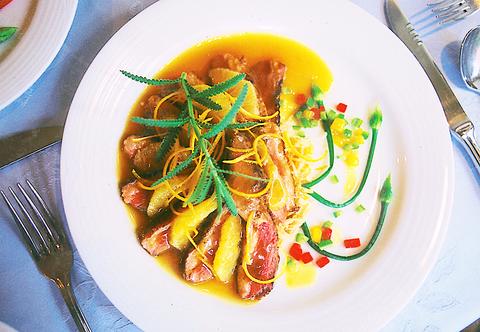Having dined unannounced at L'escargots, I could believe it when a waitress told me that ingredients for the NT$480 business lunch would cost the restaurant as much as NT$300. Now open for about two years, the restaurant defies the norms of Taipei gourmet dining by offering unreasonably reasonable prices for unreasonably delicious food. Currently the most expensive dinner set, lobster thermidor, costs only NT$780. At the other end of the menu, the range begins with stuffed pike in white wine sauce for NT$530. Anything you eat will be marvelous, and if that were not enough, the waitstaff provides knowledgeable and impeccable service, the tables are far enough apart, and the atmosphere is friendly and local -- a happy alternative to the aloof, five-star environments that usually signify Taipei gourmet. All told, there's so much right with this restaurant, it's hard to note any flaws.
L'escargots' head chef, Yeh Yeong-ming (
To keep the menu fresh and in season, Yeh brings in almost completely new menus once every three to four months. The business lunch set, meanwhile, changes weekly.

PHOTO: DAVID FRAZIER, TAIPEI TIMES
Six-course dinner sets include a choice of five appetizers, soup, salad, main course, dessert and coffee or tea. The pacing and proportions of the various courses are so perfect it's almost magical. Needless to say, he's trained his staff quite well -- to the point, in fact, that they will probably know better than you which wines from the cellar will go with your meal. It's a welcome change from more standard and stand-offish fine dining, where black-tied waiters snatch plates the moment the fork has been implanted into a dish's final morsel -- in effect rushing you out of the restaurant. At L'escargots, courses ebb and flow naturally, as if the wait staff could read your mind, or at least your appetite.
One of the only dishes that never changes is the restaurant's namesake, escargots bourguignon, a truly delicious dish that no one should pass up. Yeh makes it by first sauteing the shelled snails in garlic and spices, then simmering them in beef broth for at least two hours, making them tender and fully impregnated with the broth. Afterwards they are baked underneath a batter of butter, egg and garlic, which seals in their extraordinary flavor. Yeh says that the recipe is French, but has been adjusted to tone down some of the stronger flavors. I would say it's its own unique brand of perfection.

June 2 to June 8 Taiwan’s woodcutters believe that if they see even one speck of red in their cooked rice, no matter how small, an accident is going to happen. Peng Chin-tian (彭錦田) swears that this has proven to be true at every stop during his decades-long career in the logging industry. Along with mining, timber harvesting was once considered the most dangerous profession in Taiwan. Not only were mishaps common during all stages of processing, it was difficult to transport the injured to get medical treatment. Many died during the arduous journey. Peng recounts some of his accidents in

“Why does Taiwan identity decline?”a group of researchers lead by University of Nevada political scientist Austin Wang (王宏恩) asked in a recent paper. After all, it is not difficult to explain the rise in Taiwanese identity after the early 1990s. But no model predicted its decline during the 2016-2018 period, they say. After testing various alternative explanations, Wang et al argue that the fall-off in Taiwanese identity during that period is related to voter hedging based on the performance of the Democratic Progressive Party (DPP). Since the DPP is perceived as the guardian of Taiwan identity, when it performs well,

A short walk beneath the dense Amazon canopy, the forest abruptly opens up. Fallen logs are rotting, the trees grow sparser and the temperature rises in places sunlight hits the ground. This is what 24 years of severe drought looks like in the world’s largest rainforest. But this patch of degraded forest, about the size of a soccer field, is a scientific experiment. Launched in 2000 by Brazilian and British scientists, Esecaflor — short for “Forest Drought Study Project” in Portuguese — set out to simulate a future in which the changing climate could deplete the Amazon of rainfall. It is

Artifacts found at archeological sites in France and Spain along the Bay of Biscay shoreline show that humans have been crafting tools from whale bones since more than 20,000 years ago, illustrating anew the resourcefulness of prehistoric people. The tools, primarily hunting implements such as projectile points, were fashioned from the bones of at least five species of large whales, the researchers said. Bones from sperm whales were the most abundant, followed by fin whales, gray whales, right or bowhead whales — two species indistinguishable with the analytical method used in the study — and blue whales. With seafaring capabilities by humans